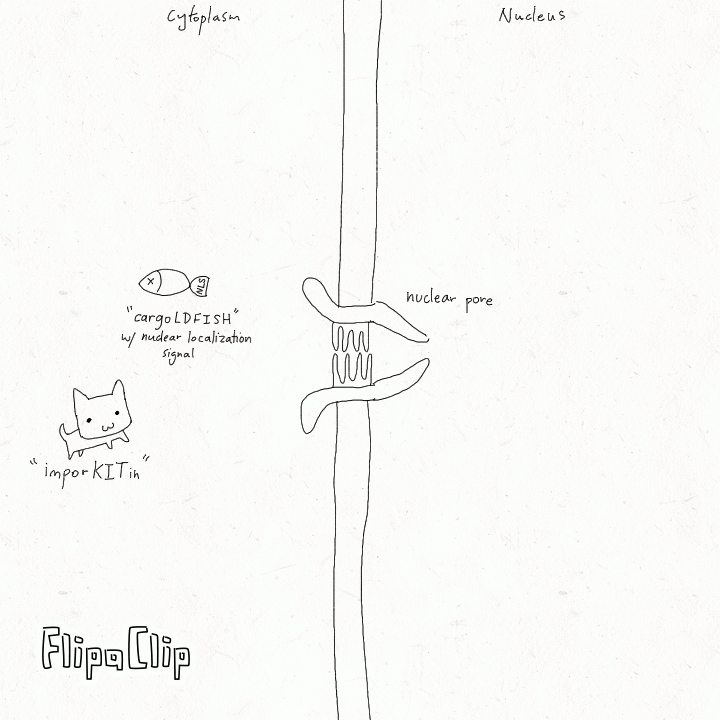Sherry Fan created a piece of art for fun that ended up published in a prestigious science journal
Ribosomal frameshifting in coronaviruses
Image Credit: Sherry Fan, published in the scientific journal Virology
Sherry Fan is a doodler. Whenever something in one of her classes captivates her imagination, the University of Maryland (UMD) senior finds herself drawing it on her iPad. In her spare time, she crafts color illustrations and little animations to convey the complex scientific concepts she learns as a dual-degree student in Nutrition and Food Science (College of Agriculture & Natural Resources) and Biological Sciences (College of Computer, Mathematical, and Natural Sciences).
In January 2021, Fan’s compulsion to turn those concepts into art landed her work in a scientific journal, accompanying a paper written by Jonathan Dinman, chair of the Department of Cell Biology and Molecular Genetics at UMD. “Because I find biology so vivid and beautiful, whenever I learn something really fascinating about science, I can't help but want to draw it,” Fan says. “I’m always trying to think of creative ways to depict whatever I've learned.”
In October 2020, Fan participated in a global art challenge event called Inktober, where artists post one original piece of work based on a specific prompt for each day of the month. “On about day 12, the prompt was ‘slippery,’” Fan says, “and because I was taking virology, all I could think about was ribosomal frameshifting.”
Probably not the typical image that comes to mind for “slippery,” but Fan was drawn to the idea that this frameshifting process—in which the genetic code-reading machinery in viruses skips a letter of code and switches from making one type of protein to another—is a slippery sort of thing. And so, that’s what she drew. Fan created an illustration on her iPad using software called Procreate and sent it to her virology course instructor. Her instructor forwarded it to Dinman, who has studied ribosomal frameshifting for many years.
Dinman loved Fan’s illustration, and the timing was perfect. He had a paper coming out on frameshifting in coronaviruses, so he asked Fan if she could modify her artwork to be specific for coronavirus. “I was immediately struck by how Sherry was able to convey the whole story in a single panel by a minimum of lines and bold colors to convey a sense of playful movement,” Dinman says. “It is a perfect example of the power of a well-executed cartoon.”
Being published in a scientific journal was thrilling to Fan, but it wasn’t her first brush with success in art. As a student at Montgomery Blair High School in Silver Spring, Maryland, Fan regularly took art classes after school and entered her work in various competitions. Her depiction of two hands holding blueberries won a high score in painting in the 2016 Congressional Art Competition, and her painting of a ring-necked duck won first place in the Maryland division of the National Junior Duck Stamp Art Contest, which is hosted annually by the U.S. Fish and Wildlife Service to spread awareness of wetland conservation.

Fan adjusted a sequence of letters to depict the correct RNA code and added a three-pronged, knot-like structure unique to coronavirus. Then, in January, Fan’s illustration accompanied Dinman’s article in the journal Virology.
Throughout her college career, Fan has continued to express herself through art at every opportunity. As part of the student volunteer organization Gift to Uplift, she illustrated three personalized story books for sick children who were participating in medical studies at the National Institutes of Health.
Fan also incorporates art into her role as an undergraduate teaching assistant for genetics, principles of organismal biology and mammalian physiology courses. Her doodles are an important tool for conveying lessons in an engaging way. Her animated GIF of a cat carrying a fish through a gate helps clarify a process called nuclear transport, in which molecules move through pores in the membrane of a cell’s nucleus. “Usually when I see biochemistry or cell biology animations, it's just one protein blob interacting with another protein blob,” Fan says. “But I find that when I use two cartoon characters, it can make the topic a lot more appealing to more people.”
Fan believes her ability to make science accessible through art will be a valuable asset as she pursues a career combining research and clinical medicine.

“In the future as a physician scientist, I really hope to use art as a way of communicating knowledge to both my patients and also to communicate my research,” Fan says. “In terms of patients, I really want to help them understand whatever illness they're going through or whatever procedure they might experience. And on the research end, it's really important for me to be able to share my findings with everyone. I think art will really help me to do that.”
After she graduates in May 2021, Fan plans to earn an MD and a PhD in biochemistry. Wherever that path eventually takes her, it is certain she’ll be making art along the way.
See the original story published by the College of Computer, Mathematical, and Natural Sciences.
Watch a two-minute interview with Sherry Fan including the creation of her illustration and how she modified it.